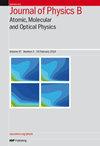飞秒激光脉冲照射结构化目标所驱动的增强型正电子加速度
IF 1.5
4区 物理与天体物理
Q3 OPTICS
Journal of Physics B: Atomic, Molecular and Optical Physics
Pub Date : 2024-03-21
DOI:10.1088/1361-6455/ad31b1
引用次数: 0
摘要
我们提出了一种紧凑的方案,利用二维粒子入胞模拟和数值分析,通过超强激光脉冲照射不同形状的目标来产生高密度和高能量的正电子。我们的模拟结果表明,当使用强度为 4×1023 Wcm-2 的激光时,布雷特-韦勒过程在激光-靶相互作用过程中主导正电子的产生。我们获得的正电子束能量为 2.5 GeV,总数超过 109 个,与之前使用相同激光强度的工作相比,提高了两个数量级。通过使用不同形状的目标,我们能够产生低发散的高能正电子束。正电子对的产生取决于靶和激光参数,我们研究了靶的形状如何提高对的产生并减少发散。我们的分析和模拟结果表明,这种高通量、低发散的正电子光束可直接应用于医学和天体物理学领域,并可在即将建成的高强度激光设施中进行探索。本文章由计算机程序翻译,如有差异,请以英文原文为准。
Enhanced positron acceleration driven by femto-second laser pulses irradiating structured targets
We have proposed a compact scheme for generating high-density and high-energy positrons by irradiating different shaped targets with an ultra-intense laser pulse, using 2D particle-in-cell simulations and numerical analysis. Our simulations show that the Breit–Wheeler process dominates positron production during laser-target interaction when a laser with an intensity of
4 × 10 23 W cm − 2 is used. We obtain a positron beam with an energy of 2.5 GeV and a total number exceeding 109, which is an improvement by two orders of magnitude compared to previous work with the same laser intensity. By using different shaped targets, we are able to generate a high-energy positron beam with low divergence. The yield of positron pairs depends on both the target and the laser parameters, and we have investigated how the shape of the target can enhance pair production and reduce divergence. Both of our analytical and simulation results demonstrate that this high-flux and low-divergence positron beam has direct applications in the field of medical and astro-physics that can be explored in the upcoming high intensity laser facilities.
求助全文
通过发布文献求助,成功后即可免费获取论文全文。
去求助
来源期刊
CiteScore
3.60
自引率
6.20%
发文量
182
审稿时长
2.8 months
期刊介绍:
Published twice-monthly (24 issues per year), Journal of Physics B: Atomic, Molecular and Optical Physics covers the study of atoms, ions, molecules and clusters, and their structure and interactions with particles, photons or fields. The journal also publishes articles dealing with those aspects of spectroscopy, quantum optics and non-linear optics, laser physics, astrophysics, plasma physics, chemical physics, optical cooling and trapping and other investigations where the objects of study are the elementary atomic, ionic or molecular properties of processes.

 求助内容:
求助内容: 应助结果提醒方式:
应助结果提醒方式:


